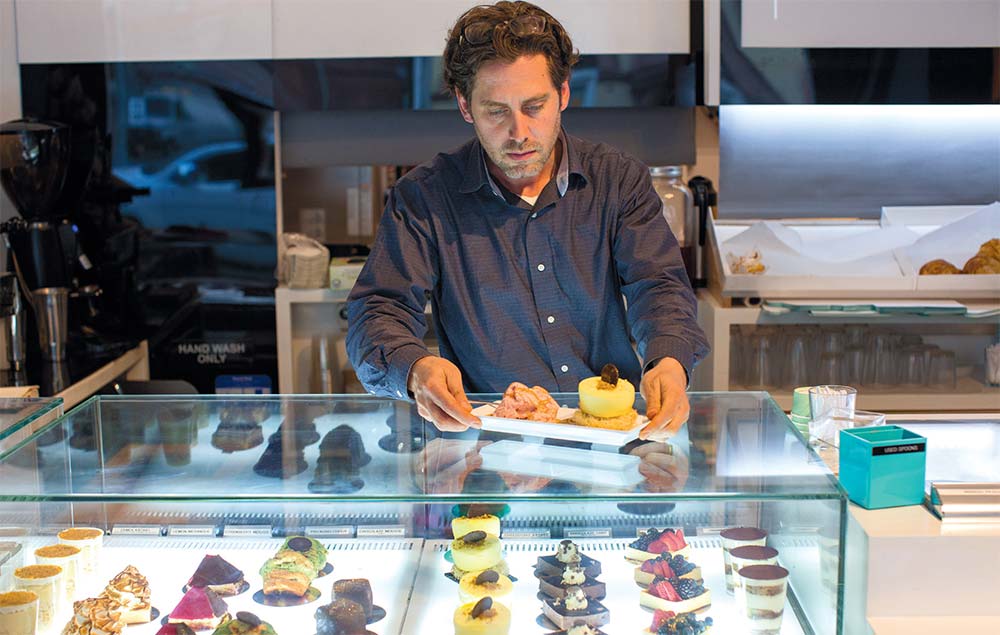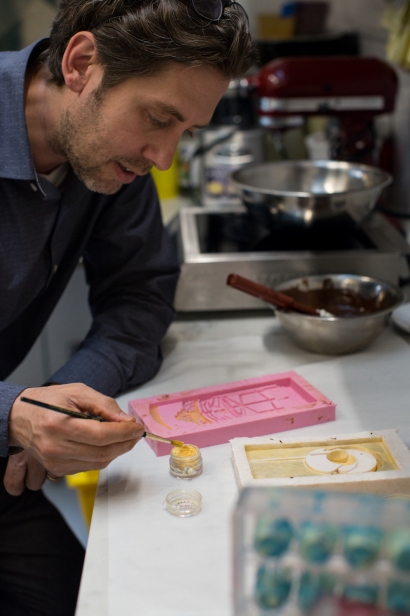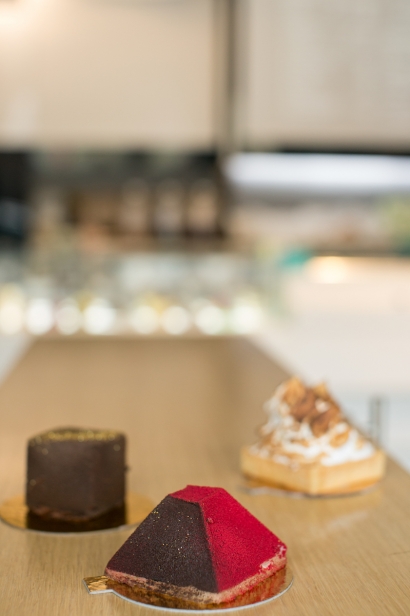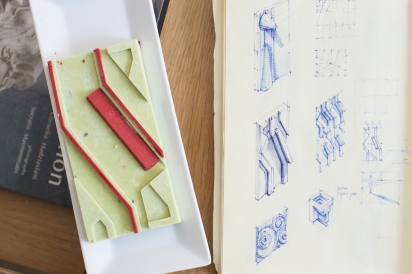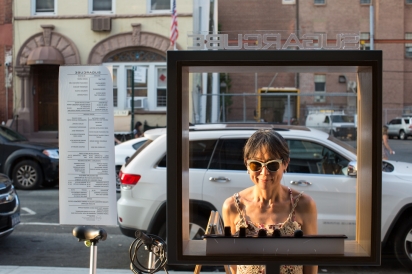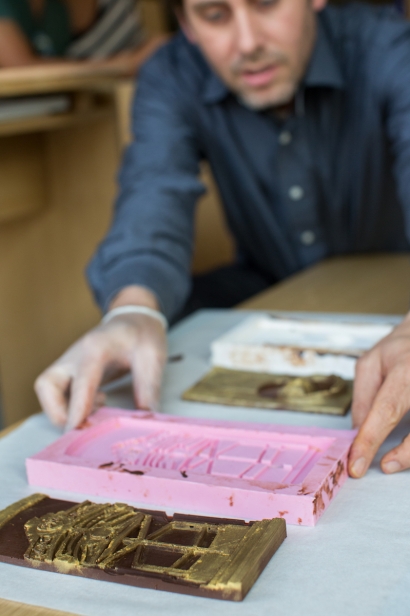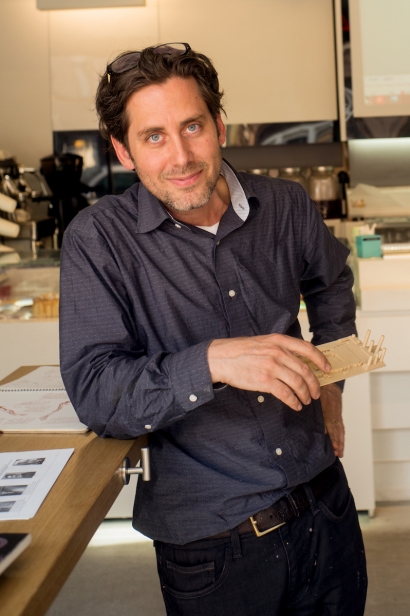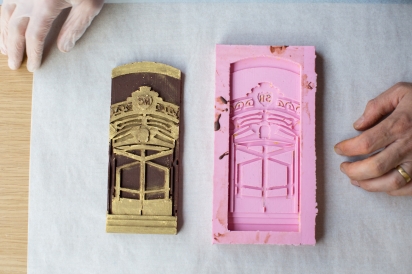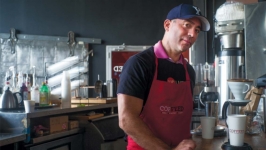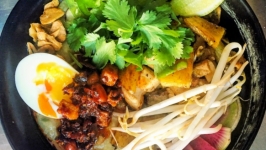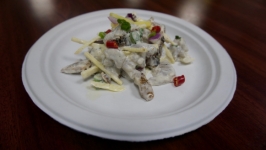Form and Flavor
Sugarcube Dessert & Coffee (now shuttered) in Long Island City may look like any other high-end pastry shop, but there is more to the story. Opened last spring, its sleek floor-to-ceiling glass invites even the less curious to take a peek. Owner and chef, Peter Zaharatos, shows just how much he enjoys playing with angles as well as sugar.
“It’s designed so that when someone comes in here, they’re kind of trapped between the gelato and the desserts,” Zaharatos said of the space, adding, “It’s not trickery, it’s basically geometry,” reflecting on the shop’s modern gray and white design.
In addition to running Sugarcube, Zaharatos owns a design firm and teaches at the New York City College of Technology. Much of Zaharatos’ architectural work involved 3D printing and modeling. This fascination with form and design governs every aspect of Sugarcube. Everything in the shop, from the chocolates to the design, is based on models generated by Zaharatos’ MakerBot Replicator 2 3D printer.
It’s easy to miss the squat black device that sits just inside the door, but not its significance. “The printer is something so unique and so personal to me,” he explained. “That’s not a machine, it’s an extension of my creativity; it’s another chef.”
Zaharatos uses the printer to create plastic positive forms which are then used to create negative shapes out of food-grade silicon. The mold allows him to make truffles, for example, into shapes like cylinders, cubes and gems that come in 10 flavors, including salted caramel, pistachio, mint and dark ganache. Gem-like sour cherry and whiskey crunch chocolate truffles sit in a well-lit case beside a rotating selection of gelato and exquisite pastries. Zaharatos is quick to point out that though each of the three display cases—one each for chocolates, pastries and gelato—may appear to be different, each is precisely four feet and one inch long. “I designed the space to kind of fit that idea geometrically.”
Zaharatos originally wanted to name the shop Sugar3, playing off of the mathematical exponent. “Everyone made fun of me,” he said of his concept. “My family, my wife and my brothers said that no one would get it, so Sugarcube became the best alternative,” Zaharatos said with a laugh.
The desserts in the glass case run the gamut from tiramisu and lemon meringue to ekmek kataifi and pistachio choux, with the latter two speaking to Zaharatos’ Greek heritage. The nuts in the pistachio choux come from his father-in-law’s groves on the island of Aegina off the coast of Athens. Ekmek kataifi is a specialty of Zaharatos’ mother, Anna. Pistachio creme fraiche sits atop a cloud of custard infused with mastiha, a slightly piney Greek flavoring made from the sap of the evergreen mastic tree. Kataifi, filaments of shredded wheat soaked with a honey orange syrup, form the foundation of one of the shop’s most traditional Greek desserts.
Mastiha, which Zaharatos said is renowned for its ability to heal ulcers, was used as a chewing gum by the Greeks and Romans and is also used to flavor his vanilla gelato.
“In Greece, dessert is not looked at as a guilty pleasure, but more like an experience you look forward to,” Zaharatos pointed out. “Everybody goes out for dessert and coffee in the evenings, especially in the summer when the days are very hot.”
The chocolate mousse cube and raspberry mousse pyramid are both Zaharatos’ own creations, a nod to his background as an architect. “Customers always really connect to those two forms. They’re very pure,” Zaharatos explained, adding, “The pastry chef is looking at the flavor and working towards an aesthetic. I’m looking at the form first and then I’m going towards the flavor. What flavor should a polyhedron be?” he asked.
The shop’s signature $10 chocolate bar is named for something Zaharatos calls the Cassandra tile. Taken by itself each bar is pretty enough, but when you combine it with another it creates a pattern, a concept Zaharatos says comes from M.C. Escher, the Dutch graphic artist. “I called it the Cassandra tile because Cassandra was a Trojan princess, given the power of sight by Apollo. The tile by itself doesn’t have much meaning until you put it together with other tiles like it, then it makes up a pattern,” Zaharatos explained. The architect-turned-chocolatier is often asked to design customized bars and is currently working on one for the St. Regis Hotel in Manhattan based on the hotel’s iconic revolving doors.
Zaharatos’ philosophy is best summed up by an Einstein quote that graces every one of the chocolate bars: “Logic will take you from A to B, but imagination will take you everywhere … It’s forces, invisible forces. You’re not sure how it’s done.”
Sugarcube Dessert & Coffee | @sugarcubelic
New York City College of Technology
M.C. Escher | @mc_escher
St. Regis Hotel | @stregishotel


